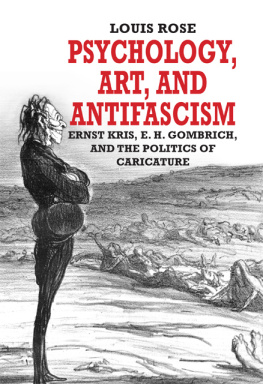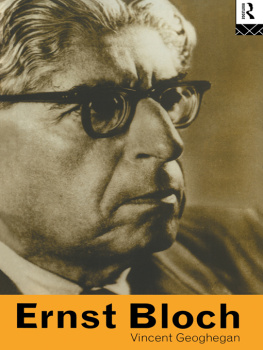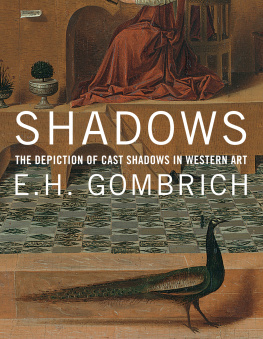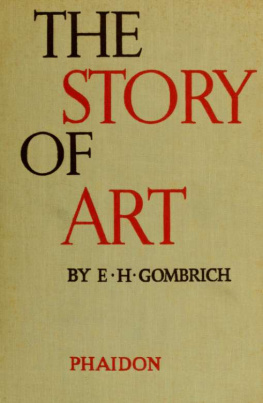PSYCHOLOGY, ART, AND ANTIFASCISM

Copyright 2016 Louis Rose
All rights reserved. This book may not be reproduced in whole or in part, in any form (beyond that copying permitted by Sections 107 and 108 of the U.S. Copyright Law and except by reviewers for the public press) without written permission from the publishers.
For information about this and other Yale University Press publications, please contact:
U.S. Office:
Europe Office:
Typeset in Adobe Caslon Pro by IDSUK (DataConnection) Ltd
Printed in Great Britain by Gomer Press Ltd, Llandysul, Ceredigion, Wales
Library of Congress Cataloging-in-Publication Data
Names: Rose, Louis, author.
Title: Psychology, art, and antifascism : Ernst Kris, E.H. Gombrich, and the politics of caricature / Louis Rose.
Description: New Haven : Yale University Press, 2016.
LCCN 2016015878 | ISBN 9780300221473 (hardback)
LCSH: Kris, Ernst, 1900-1957. | Gombrich, E. H. (Ernst Hans), 19092001. | Art historiansAustriaBiography. | Psychology and art. | BISAC: ART / Criticism & Theory. | BIOGRAPHY & AUTOBIOGRAPHY / Social Scientists & Psychologists. | PSYCHOLOGY / Movements / Psychoanalysis. | ART / Techniques / Cartooning.
Classification: LCC N7483.K75 R67 2016 | DDC 700.1/9dc23
LC record available at https://lccn.loc.gov/2016015878
A catalogue record for this book is available from the British Library.
10 9 8 7 6 5 4 3 2 1
For permission to reprint lines from Jessica Mitfords autobiography Hons and Rebels (2004), the author and publishers gratefully acknowledge New York Review Books. Copyright 1960, 1989 by Jessica Treuhaft.
For Clelia and Asher
CONTENTS
ILLUSTRATIONS
Unless otherwise stated, all artwork featured is by Honor Daumier.
La dposition dune mineure (drawing on paper), c. 186568. Ny Carlsberg Glyptotek, Copenhagen. Photo: Ole Haupt.
Rue Transnonain, le 15 avril 1834, Lassociation mensuelle lithographique, 2 October 1834. Benjamin A. and Julia M. Trustman Collection of Honor Daumier Lithographs, Robert D. Farber University Archives & Special Collections Department, Brandeis University.

1. After Charles Philipon, Les Poires. Philipon originally depicted the kings transformation into a pear as a satiric, unsuccessful legal response to charges of sedition. At a court appearance on 14 November 1831, he submitted into evidence a sketch of the four figures to show the extremes to which the government would have to go if it intended to suppress all possible likenesses of the king. After the trial, references to and depictions of the pear resurfaced in Paris, not only in Daumiers rendering in Philipons Le Charivari but also in newspapers, on stage, in graffiti, and even on storefronts.

2. Le pass. Le prsent. Lavenir. Here Daumier combines within a single configuration the features of the self-satisfied bourgeois and the oppressive monarch. The bourgeois past contains the authoritarian future.

3. Trois amateurs devant La revue nocturne de Raffet. Daumier admired the work of Auguste Raffet, whose well-known lithograph of Napoleon I reviewing his troops at night draws the three mens attention here. Daumiers reminder of Raffets somber, ethereal print perhaps meant also to provoke a comparison between the first and second Napoleons, of whom Marx famously wrote in the opening of The Eighteenth Brumaire of Louis Napoleon that all great historical events happen twice, the first time as tragedy and the second time as farce.

4. Lamateur destampes. The exhibition in Vienna was likely the first time this print appeared in an exhibition devoted to Daumiers work.

5. Le ventre legislatif. The image included the subtitle: Aspect des bancs ministriels de la chambre improstitue de 1834. (View of the ministerial benches in the improstituted house of 1834.) Daumiers depiction of the legislative benches, with the deputies assembled in rows, provided a group portrait of the bourgeois representatives of the people. Two months later, the people of Paris built barricades against their government.

6. La dposition dune mineure. The session in which the judges question the girls testimony is closed, intensifying the remoteness and harshness of the process. At one time, this picture belonged to Edgar Degas.

7. La Soupe. Daumier might have intended this drawing to serve as an initial study for a larger painting of the family.

8. Belle dame, voulez-vous bien accepter mon bras? Here Daumier depicts not only the falsehoods of Napoleonic agents in particular but also the hollowness of support for the Second Republic in general.

9. Ratapoil. In spring 1851, Daumier created a clay model of the figure of Ratapoil, who already had begun to appear in Daumiers lithographs. Soon after, it was cast in plaster. In 1891, under the Third Republic and at the instigation of Armand Dayot, Inspecteur des Beaux-Arts, a bronze casting was made, although it was not initially displayed in public.

10. La rve de linventeur du fusil aiguilles le jour de la Toussaint. On All Saints Day, the inventor of the machine gun visits, in his fantasy, a graveyard of his making. Louis Napoleon had intended to keep the manufacture of the French mitrailleuse in 1866 a military secret, but word of its production began to leak out. This lithograph was included in the antiwar collection Daumier und der Krieg (Daumier and War), published in Leipzig, Germany, in 1926.

11. Une laurate en 1868. Frequent European treaty negotiations had followed continuous military actionsthe 1864 French occupation of Mexico to install Emperor Maximilian, the Prussian occupation of Schleswig-Holstein in the same year, and the Prussian defeat of Austria in 1866and they preceded the build-up to the Franco-Prussian War of 1870. This lithograph was also included in the
Next page






















